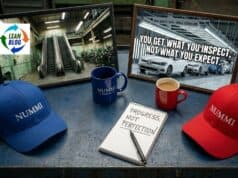Mark's note: What follows is a guest post by Keivan Zokaei about the necessary and unsurprisingly overlap between Lean principles and environmental stewardship. I wrote about this dynamic in a 2010 blog post: “Lean Leads to Green, Which Supports Lean,” about the work done by one of my former clients, Children's Medical Center Dallas.
By Keivan Zokaei, S A Partners
 “Lean and green is free, but it is not a gift[i]“. It might seem counterintuitive, but lowering our impact on the environment means lowering costs. The reasons are the same ones that underpinned the “quality movement” of 1960s and 1970s. When making poor quality products (or services), we waste time, energy, and resources. So, not making mistakes in the first place is much cheaper and also guarantees better customer satisfaction. By the same token, sustainable business means not wasting resources and energy, which, in turn, means cheaper and better products.
“Lean and green is free, but it is not a gift[i]“. It might seem counterintuitive, but lowering our impact on the environment means lowering costs. The reasons are the same ones that underpinned the “quality movement” of 1960s and 1970s. When making poor quality products (or services), we waste time, energy, and resources. So, not making mistakes in the first place is much cheaper and also guarantees better customer satisfaction. By the same token, sustainable business means not wasting resources and energy, which, in turn, means cheaper and better products.
Today, the “sustainability movement” stands where the “quality movement” stood around 40 years ago. As with the quality movement, the issue with Lean and green is NOT what people don't know, but rather what people think they know about it. The prevailing paradigm for Lean thinkers is that “environment is a cost”. That's why far too many Lean practitioners delay the integration of Lean and green.
If it's not a priority for you, then it should be. Just like the quality movement, the point of focusing on the environment is not the environment per se, but rather the business competitiveness that this new paradigm offers. That's exactly why the companies that move fastest to adopt the idea of “environment is free” are the billionaires of tomorrow. Today, greening your business is not just a “nice to have”— it is now a “must have” just the way lean has been an absolute necessity for most businesses for decades.
Lean means doing more with less. That's why Lean thinking supports green thinking and vice versa. Nonetheless, economic and environmental continuous improvement are separate organizational silos and sometimes even come into conflict with each other. Most environmental managers are pre-occupied with check-lists and compliance work. That is silly. The value of Lean and green is to go beyond compliance, to build environment into the process and into the culture of the organization. This is the same thing that Toyota is doing as I will explain in the following. Similarly, lean practitioners can have an unfortunate tendency to see environmental programs as a threat. Many are even intimidated by the “environmental currencies,” such as waste or emissions, not knowing what they really mean. That is silly too! And it could well be the biggest opportunity missed across most industries.
Recently, I worked with one of the largest sandwich factories in the world. A team of great managers and shop-floor staff engaged in a program to reduce physical waste. We began by creating a mass-balance for the whole site looking at the inward flows of virgin material and the outward flows of trash. Interestingly, this simple exercise showed that there was nearly 6500 tons of solid waste (including wasted bread, wasted ingredients, packaging wastes, etc). It also showed there was around 1500 tons of liquid waste going down the drain. The Lean and green team then used simple Lean tools and techniques such as value stream mapping and A3 problem solving, to tackle the root causes of waste.
The results were astounding, with nearly 1000 tons of trash prevented in just a few weeks, in a very mature industry. For example, one of the key areas was to apply basic Six Sigma principles to the thickness of the bread slices and by reducing variation to effectively obtain one more slice out of each loaf of bread. Add to that the fact that they saved nine million liters of water from going down the drain by applying better Standard Operating Procedures to the cleaning regime and in the tray wash area. The commercial benefits were even more staggering. You will be pleasantly surprised when you put lean and green together. For more information see this link.
The power of Lean and green is to bring the two together. There is much that the sustainability movement can learn from the Lean and quality community, in terms of structures and methods for systematic and systemic change management. But, more importantly, the Lean community has to adopt a new purpose; and that new purpose is simultaneous pursuit of Lean and green. When we prevent physical waste, increase energy efficiency or improve resource productivity, we save money, improve profitability and enhance competitiveness. Environmental waste is the best proxy for identifying and eliminating economic waste. In order to once again contribute to the continuous improvement of our organizations, we (the Lean family) can and should use the environmental waste as a proxy for identifying key areas for economic improvement, the same way we use the lean wastes as a proxy. This is the next breakthrough for your company and maybe for your career too!
Recently Hunter Lovins, Andy Wood, Peter Hines and I co-authored a book titled “Creating a Lean and Green Business System: Techniques for Improving Profits and Sustainability“. We looked at several companies, such as Toyota, Adnams, Tesco, Marks and Spencer and MAS, in detail to explain how they are leading the way in terms of lean and green.
For example, Toyota, already in its fifth five-year Environmental Action Plan, has announced that it will improve the average fuel efficiency of its vehicles by 25% in all regions by 2015 compared to that of 2005. In production, Toyota has already reduced emissions per vehicle by 37% between 2001 and 2012. No one familiar with the company is surprised. These improvements are rooted in its Kaizen mentality. The day-to-day environmental Kaizen in Toyota is guided and driven by ‘five year environmental action plans' that set tangible goals for all areas including production, facilities, transport and offices as well as specific regional targets for various plants. For Toyota, it's key to have a cascaded measurement systems which provide effective KPI's at the right level to enable people to improve continuously. Across all Toyota plants, there are basic measures in place for everybody, all the way from top board to the local level. These are, in the order of our priority: safety, environment, quality, production and cost. Improvement is continuously measured against these five criteria. A Toyota executive told me “we regard safety of our members and our customers with our environmental commitment to society as our permission to operate[ii]“.
The starting point for creating a Lean and green business system is the mind set of senior managers. It is hard to deliver the type of results we have seen from leading edge organisations such as Unilever, Dupont, GE, Toyota and M&S without executive commitment. The key point in this transition is the understanding that there is no trade-off between Lean and green, that lean and green should be brought together, as Toyota has done. In achieving this integration, there is a great deal we can learn from the paradigm shift that occurred during the 1960s and 1970s across the Western world as managers came to realize that there was no trade-off between quality and cost.
[i] I borrow from Phil Crosby whom famously said “quality is free, but it's not a gift”.
[ii] For more information refer to Creating a Lean and Green Business System (2013) by Zokaei, Lovins, Wood and Hines, Productivity Press.
About Keivan Zokaei: Keivan is a lean thinker, management consultant and author. He is an honorary Visiting Professor at the University of Buckingham with years of experience at the cutting edge of lean thinking specializing in operations management and supply chain management. Previously Keivan was a director at the Lean Enterprise Research Centre at Cardiff University.
Keivan has also been an advisor to the Auditor General in Wales on how to improve public services and has advised different European governments on the principles of lean and systems thinking as well as publishing a number of key reports commissioned by governmental or industrial bodies. He is a regular speaker at different international conferences and engages with both lean professionals and general business executives through public media including appearances on BBC.
Please scroll down (or click) to post a comment. Connect with me on LinkedIn.
If you’re working to build a culture where people feel safe to speak up, solve problems, and improve every day, I’d be glad to help. Let’s talk about how to strengthen Psychological Safety and Continuous Improvement in your organization.









Crystal-clear!
Keivan is bang on with this posting. I have been working in the lean area for 25 years and been thinking about integrating green right from the start. It seems to me that now the world has seen that we need to bring lean and green together. This is the next frontier of lean thinking!
Jeff Rich at Gundersen Health in LaCrosse, WI is doing a fabulous job of applying lean principles to energy management and environmental sustainability. As far as I know, a leader in applying the concepts and thinking in the healthcare arena. Check out their site at, http://www.gundersenenvision.org/our-plan.
@ Jack: Similar message. Thanks for sharing. I encourage mapping of your lean and green journey (as discussed in our recent book). A very important feature of lean and green is to go beyond lean tools and techniques (exactly like lean!). To create a roadmap which integrates cultural issues as well as strategy deployment…
[…] What follows is a guest post by Keivan Zokaei about the necessary and unsurprisingly overlap between Lean principles and environmental stewardship. The following article featured on http://www.leanblog.org […]
In case any of you are interested in more conversation on this very topic, Don Berwick will be leading a panel discussion at the IHI conference in December titled “Environmental Sustainability and the IHI Triple Aim”. Hopefully more people can become aware of the synergies. I see many opportunities for Lean professionals and Lean methodology to be applied to reduce environmental waste and make healthcare organizations more efficient.
[…] What follows is a guest post by Keivan Zokaei about the necessary and unsurprisingly overlap between Lean principles and environmental stewardship. The following article featured on http://www.leanblog.org […]
Quality is not free. There are Costs of control and there are Costs of failure to control quality. Consequentially there is an optimum. The same goes with lean and sustainability. The most simple example is the aspiration of zero Stock, which necessitates more transport, increasing CO2 exhaust. There are definitely Many example of lean and sustainability Going hand in hand, but Also Many examples of Trade-offs, where an optimum is Called for. At least temporarily. Lean should be treated as a calculative practice not a religion
Classmates and I argued with our MBA econ professor who claimed there was an “optimal” quality and optimal defect rate that was acceptable.
These models usually seriously underestimate the cost of poor quality in terms of lost customers and bad word of mouth.
I think most organizations are FAR from the part of the curve where better quality might cost more, especially in healthcare.
You’re certainly right that “just in time” shouldn’t be taken to an extreme. You’re not going to order one part at a time if it’s coming from China. But, if you’re Toyota and you have your suppliers located in connected buildings, then you can have low inventory AND low transportation costs.
Opportunity Costs are difficult to grasp, since they are not to be Found i. The accounting system. Maybe your Econ professor didnt consider that term. My simple example highlighted a Trade off between cost and CO2 exhaust. Even though supplier and customer are close to each other, 10 transports a week are more pollutive than 1. The Trade-off is still there
We are talking about science here not religion of course.
The cost of building quality into the system is more than cancelled out by the benefits that you get from the system. Of course, we are talking about 6 sigma capability level before further costs can be potentially not justified (as Mark commented in the above).
“Trade-off” thinking is exactly what we must avoid when it comes to lean and sustainability. By definition, innovation is when you do NOT accept a “trade-off” situation. Eradicating a trade-off, every time you come across one, is innovation. Learning from the paradigm(s) of “quality is free” is key towards lean and green innovation.
‘The cost of building quality into the system is more than cancelled out by the benefits that you get from the system’ – that is religious.. Like a universal truth. Numerous examples can be used to falsify this truth.. It can be very costly for a company to manage through religion. When you read Lean Thinking, there are religious tendencies (no trade-offs) however when you read Shingo there are trade-offs.
Comments are closed.